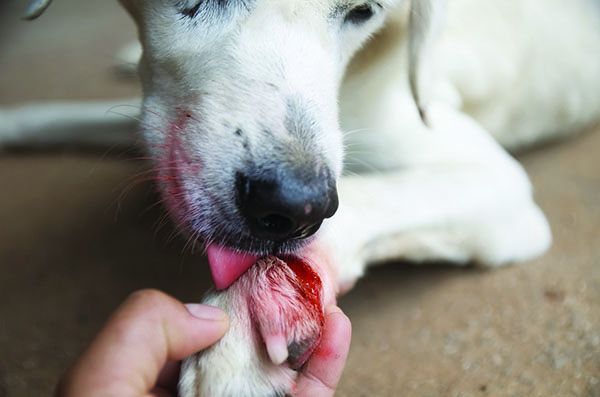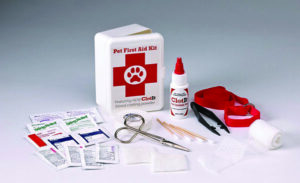
Whole Dog Journal is reader-supported. If you purchase items through links on our site we may earn a commission. Whole Dog Journal does not accept money for its food and product reviews.
Have you ever witnessed a dog fight, a dog getting hit by a car, or falling out of an open truck bed? Has your dog ever sustained a deep cut on his paw pad from stepping on a sharp shard of glass or metal, or gashed himself on some innocuous item in the yard while playing with a dog friend or chasing a ball?
Accidents and unexpected events can happen anytime and anywhere, so having first-aid supplies for dogs readily available is important. A DIY dog first aid kit can be kept in a box, backpack, shoulder bag, fanny pack, or other container, and you may want more than one for convenience: a small first aid kit for hiking, a larger one for the car (handy in an emergency evacuation), and one containing all the bells and whistles for home use.
Start by focusing on items you’re comfortable with and that fit your dog’s lifestyle. For example, an active hunting dog’s field kit will be different from one for an elderly lap dog. Once your kit is assembled and in a convenient location, examine its contents every few months and replace expired items while refreshing your memory about what you have and what to do with it.
Here are a dozen general categories that can be the foundation of your dog’s DIY first-aid kit:
- Documentation
- Towels or blankets
- Bandages
- Tools
- Hydrogen peroxide
- Cleanser
- Antibiotic ointment
- Styptic powder
- Bottled water
- Wet wipes
- Cold packs
- First aid guide
Start with the most important items and build from there.
1. Documentation. Your dog’s license, vaccination records, medical records, and veterinarian contact information along with your own contact information can help in an emergency, especially when the details are up to date and in one place. Your phone may be a convenient storage location, but if it isn’t accessible or if internet service is interrupted, you’ll want those hard-copy backups.
2. A towel or blanket and a thermal blanket. An injured or panicking dog can be soothed and calmed by being gently wrapped in a soft blanket or thick towel, which can also protect a dog lying on a hot or cold, hard, or rocky surface.
Keeping an injured animal warm is important to prevent the life-threatening effects of shock, a state in which the animal becomes hypothermic and his blood flow is severely impaired. Low blood flow can lead to damage of the vital organs like the brain and the heart. On any but very hot days, use a thermal blanket (also known as emergency, rescue, or space blanket) to keep the injured dog warm. These blankets are waterproof, lightweight, and take up very little room in first-aid kits.

3. Bandages. Gauze (sterile gauze pads or gauze rolls), elastic bandages, self-adhesive bandage material such as Vetrap, cotton balls, and fabric strips can control or absorb blood, support sprained muscles, and create a makeshift muzzle if one is needed. Wooden splints can be added to support suspected bone fractures. Note that too-tight taping interferes with circulation.
4. Tools. This category includes blunt-tip bandage scissors, tweezers, needle-nose pliers, a tick-removal tool, disposable gloves, syringes, an eyedropper, protective glasses or goggles, a flashlight with fresh batteries, a magnifying glass, an expired credit card (useful for scraping away stingers), collapsible food or water bowls, pickup bags, and a spare leash and collar.
A soft muzzle that fits your dog is a good companion piece because any dog can bite or snap when in pain, so having one on your dog while he’s being moved or examined can help prevent injury to human helpers.
5. Hydrogen peroxide. Hydrogen peroxide has long been used as a disinfecting rinse for cuts and abrasions, but its topical application has become controversial. Research shows that hydrogen peroxide may not affect all harmful bacteria, leaving some to infect treated wounds, and it damages fibroblasts, which are cells essential to the healing process.
However, hydrogen peroxide still has an important place in your first-aid kit because, when swallowed, it induces vomiting making it useful in cases of poisoning. Vomiting is not appropriate for all toxic exposures, so be sure to follow the advice of your veterinarian, poison control center, or first-aid handbook.
When vomiting is recommended, the usual dose is 1 teaspoon of 3% hydrogen peroxide (widely available in grocery and drug stores) per 5 pounds of body weight with a maximum dose of 3 tablespoons for dogs who weigh more than 45 pounds (there are three teaspoons in a tablespoon).
Lift your dog’s chin and squirt the hydrogen peroxide into the side of your dog’s mouth with a syringe or eyedropper. Some foaming at the mouth may occur. If vomiting doesn’t begin within 15 minutes, the treatment can be repeated once.
To be sure hydrogen peroxide is effective when you need it, purchase small rather than large bottles and keep track of expiration dates. Hydrogen peroxide loses its effectiveness with age and after opening.
For more details about situations when you might have to make your dog vomit and when you shouldn’t, see “How to Make a Dog Throw Up,” WDJ January 2014.
6. Wound cleaner, antiseptic rinse, saline solution. The first step in treating most wounds is removing dust, sand, gravel, mud, or other debris. Rinse the wound with plain water or a saline solution, especially if you can apply it with a hose, syringe, turkey baster, or squeeze bottle. Medical-grade saline solution, which is sold in pharmacies, has many first-aid uses, including rinsing the eyes. Scissors or clippers can be used to remove hair around the wound, if necessary.
Once the wound is rinsed, blot it with a clean towel, gauze, or cotton balls. For minor wounds, apply a non-stinging antiseptic rinse or spray. Most first-aid kits include chlorhexidine products, but you may prefer a colloidal silver spray or a treatment you can make yourself.
For more information about treating minor cuts and abrasions, see “First Aid Care,” WDJ October 2021.
7. Antibiotic ointment. Conventional first-aid kits generally come with an antibiotic ointment like Neosporin, which can be applied to cuts, abrasions, puncture wounds, and other injuries to prevent infection. For those who prefer alternative wound dressings, products that contain medical-grade Manuka honey, colloidal silver, or other natural disinfectants are widely available.
Ointments are typically applied to a wound that has been rinsed and blotted or air-dried and then, if needed, protected with a nonstick gauze pad that’s taped or wrapped in place. Most wound-salve instructions recommend replacing ointment and bandages twice or three times per day while the injury heals.
8. Styptic powder or collagen hydrolysate. Styptics are antiseptic clotting agents such as alum, ferric subsulfate, or herbs such as powdered goldenseal or yarrow. Styptic pencils, which place styptic powder directly on bleeding wounds, are convenient, but any styptic powder can be applied in small amounts using a cotton swab or spoon as an applicator. Dog groomers use styptic powder to control the bleeding of over-trimmed nails, and other styptics reduce bleeding after medical procedures such as biopsies.
A recent development in the treatment of bleeding wounds is a medical hydrolysate Type I collagen that acts as a tissue adhesive that stops bleeding, protects wounds, reduces scarring, and conforms to any wound site. The Hymed Group (hymed.com) manufactures EMT Gel and EMT Spray for general wound care and Collasate gel and spray for surgical, traumatic, and superficial wounds, first- and second-degree burns, foot-pad injuries, hot spots, and lick granulomas.
9. Bottled water and hydrating fluid. Water is an essential ingredient in any first-aid kit because it has so many practical uses, from rinsing wounds to helping prevent dehydration.
Some veterinarians recommend Pedialyte (an electrolyte replacement fluid for infants and children) because its combination of water and minerals can help dogs recover from diarrhea or shock. However, Pedialyte contains more salt and sugar than is recommended for dogs, so look for liquid or powdered hydration products designed for pet use.
10. Wet wipes or grooming wipes. Keep a supply of pet grooming wipes; they come in handy for many purposes. Don’t use alcohol-based disinfecting wipes, because alcohol stings and can damage injured tissue. Instead, look for products that soothe while they clean. We like the Earth Rated Dog Wipes, which are plant-based, compostable, and unscented.
11. Hot and cold packs. Cold packs can help cool sprains, bruises, and other injuries and reduce inflammation and swelling. Hot packs can increase circulation, help the dog feel warm and comfortable, support a dog recovering from shock or injury, and speed healing.
These treatments are easy to provide at home, where you can keep a cold pack in the freezer and heat a hot pack in the microwave, wrap a hot water bottle in a towel, or use an electric heating pad designed for animals. But if you’re away, a few instant hot packs and instant cold packs will be convenient. They are sold in pharmacies and pet supply stores. To activate either product, squeeze or massage the pack, wrap it in a towel, and apply it to the affected area. Replace as needed (they’re small and don’t last long, so you may need several).
12. A pet first-aid guide or handbook. First-aid references will help you make right decisions when the unexpected happens. These can be short (covering the most common conditions) or comprehensive, and they’re most useful when you’re familiar with their layout and contents. Popular handbooks include:
- First Aid for Dogs: An invaluable guide for all dog lovers by Emma Hammett, FirstAidforPets.net, 2016.
- Canine Field Medicine: First Aid for Your Active Dog by Sid Gustafson, Mountaineers Books, 2018.
- Essential First Aid for Dog Owners by Lorrie Boldrick DVM, All Publishing Company, 2010.
- The First-Aid Companion for Dogs and Cats by Amy Shojai, Rodale Books, 2001.
Keep the phone numbers of 24/7 poison control services with your handbook and use them if you know or suspect that your dog has swallowed something toxic and you can’t reach your veterinarian:
ASPCA Animal Poison Control Center, aspca.org, (888) 426-4435. Consulting fee may apply.
Pet Poison Helpline, petpoisonhelpline.com, (855) 764-7661. $65 incident fee.
And there’s more. Wherever you live, your dog’s first-aid kit can be part of your disaster preparedness plan. Add backup supplies of medications along with packages of food or treats, a familiar toy or favorite object, spare harness and leash, and other items that will help your dog adjust in an emergency.
Your dog’s first-aid kit can be as basic or complicated as you like. Its purpose is simple – to be prepared for any emergency – and it will make a difference.






Because dogs can get hurt at any time and from any location, having first-aid materials for dogs on hand is essential. It’s possible to keep a DIY dog first aid kit in a box, a backpack, a shoulder bag, a fanny pack, or another container, and you may want to have more than one for convenience’s sake.